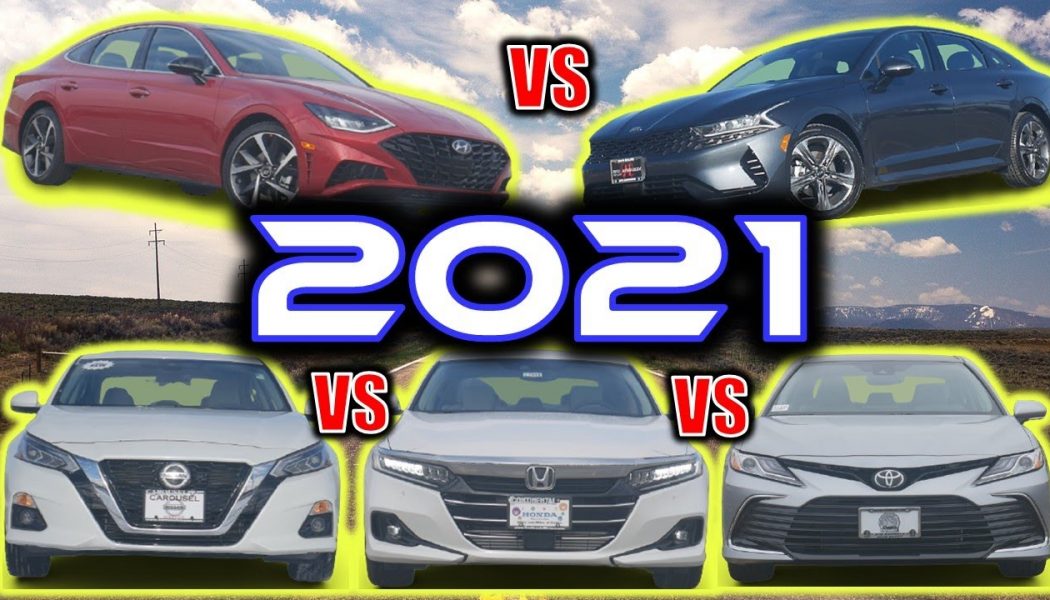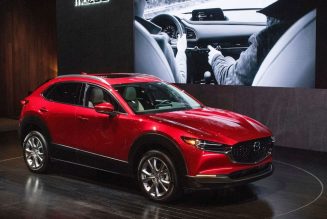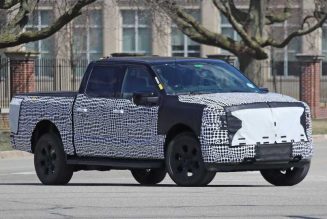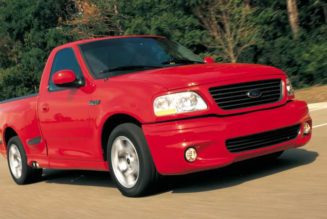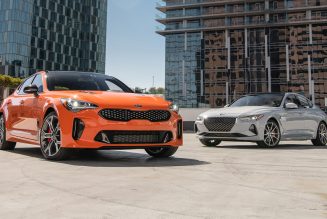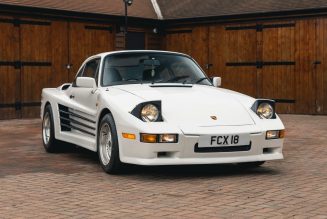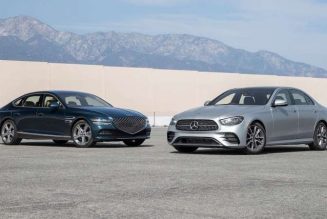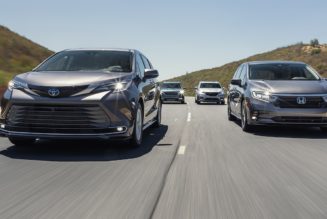The combination of reduced space and a lower ride height (relative to SUVs), and cheap gas is killing sedans. As you may have noticed, there are no American nameplates in this Big Test. Ford discontinued the Fusion, the Chrysler 200 was unceremoniously dumped before it could even complete its model cycle, and Chevrolet is reportedly letting the Malibu die after the 2023 model year—just like Volkswagen is doing with the Passat.
But the family sedan is far from dead. Americans bought nearly 1 million of them last year. Japanese manufacturers keep investing in the segment, and the Koreans are not giving up—the Kia K5 is the newest model in the segment, while the Hyundai Sonata arrived in late 2019. After all, with Detroit walking away from sedans, that market share has to go somewhere, right?
So let us defend the sedan. With better driving dynamics, superior fuel economy, and, let’s face it, much better looks than crossovers, the midsize sedan continues to be a key player in the game. But can the industry convince car shoppers to make sedans great again?
What’s Left in the Shop Window?
With our consumer hats on, we were mindful of the tight budgets people face when buying a new car, so we tried to limit each sedan to $32,000. (The average transaction price for a new vehicle in the U.S. crested $40,000 last year.) But with the pandemic causing strains on the manufacturer’s press fleets, a couple of test sedans slipped over that price ceiling.
One of them is the Mazda 6, which came with a $34,245 price tag—the most expensive car in the comparison. We’re big fans of the 6; in fact we crowned it the winner of our 2014 midsize sedan Big Test. Although the competition has changed quite a bit since then, the Mazda has not. Mazda introduced a new engine and small face-lift in 2018, but everything else under the skin remains unchanged. Our 2021 Carbon Edition‘s optional 2.5-liter turbo-four sends 227 hp and a whooping 310 lb-ft of torque through an aged six-speed automatic to the front wheels. The 6 made its mark as a driver’s car, but can it win again seven years later?
At $32,905, the 2021 Nissan Altima SR is the second-most expensive sedan in the test. Our model came equipped with the variable-compression turbo engine, an engineering marvel that makes 236 hp and 267 lb-ft. Like with most Nissans these days, it features a continuously variable transmission , which sends the power to the front wheels, though the Altima is one of the few that offers all-wheel drive (with the non-turbo 2.5). Introduced in 2018, the Altima hasn’t received any updates since.
The 2021 Kia K5 surprised everyone with its Stinger-like design, aggressive character lines, and standard turbo engine. The K5 officially replaces the Optima, which was a respectable player in the segment. Our K5’s standard 1.6-liter turbo-foursends 180 hp and 195 lb-ft to all four wheels, the first time a Kia midsize sedan has offered all-wheel drive. Our $31,430 GT-Line is trying to walk on the same path as the award-winning Telluride—delivering style and technology with a ton of value.
The 2021 Hyundai Sonata shares its platform with the K5. All-new for the 2020 model year, the Sonata impressed everyone with its fancy LED headlight array and smoothly contoured sheetmetal. Although the Sonata and K5 are vastly different outside, they get power from the same 1.6-liter turbo. (The Hyundai’s base engine is a naturally aspirated 2.5-liter, and all-wheel drive is not offered.) Crossing the check-out counter at $32,174, our Sonata SEL Plus delivers great value and loads of technology.
The Subaru Legacy has been around for more than 30 years and entered its seventh generation with the 2020 model year. Although its design might not be as enticing as the rest of the field, it does a lot of things well. Our 2021 Limited trim came equipped with the base 2.5-liter four-cylinder boxer engine, which produces 182 hp and 176 lb-ft, and it comes mated to a CVT. Like most Subarus, the Legacy has standard all-wheel drive. Our tester carried a sticker price of $30,820.
The 2021 Honda Accord received a mild midcycle update after the 10th generation’s launch in the 2018 model year. We opted for the EX-L trim, which gets a CVT and the base 1.5-liter turbo-four mill, producing 192 hp and 192 lb-ft of torque. With a $32,285 price tag, the Accord EX-L brings a well-appointed cabin for a reasonable price.
The 2021 Toyota Camry, updated with a new touchscreen and more safety features, rounds out our field. Propelled by the base 2.5-liter four-cylinder engine with 203 hp and 184 lb-ft, our SE model represented the heart of the market thanks to its $29,217 price—the lowest in this Big Test. Although the Camry is now available with all-wheel drive, our tester came with front-drive and a short list of optional equipment.
How Do They Drive?
The Accord felt like the best-engineered sedan. “It’s as if Porsche was tasked with building a front-wheel-drive economical commuter sedan,” senior features editor Jonny Lieberman said. Whether it’s the suspension, steering, or powertrain, the Accord drives so well that it quickly distinguished itself from the rest of the group. Just take a look at some of the judges’ notes: “Steering is excellent.” “Its chassis and suspension tuning are great.” “The quality of the engineering shines through.” We can go on and on.
But not everything is hunky-dory. Although its CVT is one of the best in the segment, features editor Scott Evans argued it was tuned to save fuel. “It really doesn’t rev up the engine unless you need to get on the freeway,” he said. And although the 1.5-liter turbo feels great for a base engine, our enthusiast judges wanted more punch. However, getting the optional 2.0-liter turbo adds big bucks to the transaction price. Decisions, decisions.
When we focus on the driving experience, the Mazda 6 shines. “The chassis dynamics are just excellent,” Evans said, despite its architecture being almost a decade old. The 6’s ride is settled, grabby, and almost free of body roll.
The Mazda’s 2.5-liter turbo feels way torquier than the Accord’s 1.5. “You get a little torque steer, especially because the engine makes so much low-end torque,” executive editor Mac Morrison said. The six-speed automatic, though old, doesn’t hesitate much to downshift and it shifts smoothly most of the time.
On paper, the performance champ is the Altima. It took just 5.8 seconds for the Nissan to get to 60 mph—the quickest car here. The variable-compression engine is able to deliver power quickly, but its tuning and the CVT failed to impress our judges. With the Palos Verdes Peninsula set as the stage for our test loop, the Altima’s transmission felt strained when going uphill on twisty roads or even when merging on the freeway and we generally feel there’s just too much continuous variability in this powertrain; it never feels decisive.
But judges applauded the Altima’s body control and suspension damping. Steering drew compliments, too. “It just feels good,” Morrison said. “It feels fun. It feels like there’s performance underneath you.” That’s something we don’t see much in this segment.
We were split over the two Korean entries. Just a few months ago, we compared them during our Car of the Year program and ranked the Sonata in front of its Kia cousin, given the broad range of trim levels and access to useful technologies. But there were cracks; during our COTY finalist loops, the Hyundai’s ride left us dissatisfied.
Although they are mechanically related, the K5 and Sonata feel different underneath. The Kia shows more confidence when tackling the twisty roads or broken pavement. “There’s a lot of youthful exuberance, a lot of the old Mazda zoom-zoom feeling,” Evans said of the K5. The Sonata’s damping feels a bit firmer but busier. “It seems to react twice to almost every bump in the road, and over imperfections it’s worse—as if the dampers have no rebound and just keep on compressing,” Lieberman said of the Sonata.
We were a bit torn by their shared powertrain. “Getting the K5 moving is like squeezing toothpaste out of an empty tube—It feels like you’re fighting for each and every mph,” features editor Christian Seabaugh said. Judges also complained about the engine vibration in the Sonata and the wind noise at freeway speeds.
Once the best-selling passenger car in America (for decades at that), Toyota’s Camry does a fine job on the road, but it’s short of stellar. Toyota tuned the suspension so that you feel almost every little bump in the cabin. Its four-cylinder engine, though a bit loud, delivers power quickly and feels adequate for a base mill. Morrison called its steering bland, while Evans complained about the transmission hunting gears on the highway.
Those issues aside, the Camry is more composed than it likely needs to be. “No inputs are all that impressive,” staff editor Conner Golden said, “but it’s above-average for something that will certainly never see anything curvier than the interstate.”
The Legacy might seem like a shy player with a flourishing soul—its design is not alluring, but it gets attention everywhere else. “I approached the Subaru with somewhat low expectations, but my opinion quickly changed when I buckled up and got it moving along the road,” associate editor Eleonor Segura said. Its ride is settled and controlled, with minimal motion when driving over pavement undulations—though we’d love to experience less body roll. Although its engine is gutless (8.3 seconds 0-60 mph, the slowest by far), the Legacy feels like an honest sedan.
Technology and Amenities
Sit inside the Hyundai or Kia, and you might confuse the cabin for a Mercedes-Benz. The 10.3-inch touchscreen delivers a great first impression and adds refinement to the interior. Although the map graphics are dated, the infotainment is quick and intuitive to navigate. “The interiors of both the K5 and the Sonata are stylistic triumphs when compared to the other contenders, particularly with the user interface,” Golden said. Our Sonata came equipped with a full digital display for the instrument cluster, something the K5 lacked.
But like its exterior design, the K5 shows its sportiness inside. Our tester featured a flat-bottom steering wheel, red leather seats, and an actual shifter instead of the button-operated transmission of the Sonata. The good impression continues with the panoramic roof on both sedans, but the quality of the materials falls short. “All of the premium materials look nice at first glance, but they don’t feel as premium as advertised,” Golden said of the K5, adding he’d rather spend his time in the Sonata.
Besides offering better materials, the Accord’s cabin shines by doing most everything right. It’s not flashy like the K5 or Sonata, but you might think you’re riding in an Acura. The faux wood trim looks and feels like the real thing, and although it could use a more modern infotainment interface, wireless Apple CarPlay and Android Auto improve the experience. It lacks the latest technologies, but the cabin doesn’t feel like it’s missing much.
Seabaugh argued that although the Accord’s cabin looks nice, it needs more than the black leather, textured plastics, and faux brown wood. “It’s perfectly acceptable but not exactly segment leading,” he said.
When sitting in the sub-$30K Camry, we felt poised to pull out of an Avis parking lot. Its interior—from the lack of comfort amenities to the small screen—felt subpar compared to the rest of the field. That’s the sacrifice you make when saving a few grand. Upgrade by a trim level, and fitments are pretty much on par.
The 2021 Camry has a new 7.0-inch “floating” touchscreen with an updated infotainment system that’s a definite improvement, but its graphics still look like they were designed a decade ago. We appreciate the standard leather-wrapped steering wheel and automatic climate control, but the cabin left us wanting more—despite the cost savings. “I expected this interior to be a little better, but it’s not,” Morrison said.
Perhaps most disappointing was the Altima’s lack of automatic climate control given its near-$33,000 price. It seems odd that Toyota offers a single-zone automatic climate control in the base Camry, but the Nissan’s second-highest trim doesn’t.
The rest of the Altima’s interior was bittersweet. We’re fans of the contrast stitching across the cabin and its intuitive infotainment, but there wasn’t anything interesting that stood out. “It’s like putting lipstick on a pig in some ways,” Morrison said. “The interior is rather plain, but it’s better than the Camry’s.”
The Mazda 6 has aged well outside, but age caught up with it inside. Starting with its ancient, fiddly infotainment system, and small screen, the 6 seems to be stuck in time. Although we appreciate wireless CarPlay, the technology is behind the curve. The lack of a touchscreen makes it harder to control anything, and even though the rotary control works well, everything is buried in distracting layers of menus.
Aside from its technology, Mazda interior designers can feel proud about their work—nearly 10 years into its lifecycle, the cabin continues to hold up in a premium and elegant way. The mix of red contrast stitching, aluminum trim, and the two-level dash deliver a plush sense in the cabin. “It’s an undeniably nice place to be, but the goalposts have moved. A 1975 Rolls-Royce is also nice, but this is a different time, different priorities,” Golden said.
Design is probably Subaru’s weakest point, and that shows in the Legacy’s cabin. We’re fans of the 11.6-inch infotainment screen, especially now that CarPlay works in vertical form. Besides that, there’s nothing super interesting. “Most of the materials on the interior are pretty middle of the road, though the humongous screen looks quite premium,” Lieberman said. “While there’s debate to its functionality, tasks like pairing a phone are simple.” Front passengers will enjoy the well-padded seats and a built-in tray in the dashboard—the perfect place for your phone or wallet.
Space for You and Your Stuff
The Accord, Camry, and Legacy stood out for their ample legroom and headroom, with the Honda offering the most supportive seats and class-leading rear legroom. “I could happily spend a day back here,” Seabaugh said. The K5, Sonata, and Altima fall right behind them, with the Kia and Nissan offering slightly more legroom than the Hyundai.
Although Mazda claims the 6 has more rear seat room than the Koreans and the Altima, it doesn’t feel like that in real life, as we felt more cramped than we did in any other sedan. “Its rear seat is comfortable and has plenty of legroom, but headroom and shoulder room are right on the edge of what I consider cozy,” the 5-foot-9 Evans said. “A taller person might find it a little too snug.”
With two USB ports, air vents, and heated seats, the Legacy was the best-equipped sedan for rear passengers. At this price point, this Subie is the only one to offer all of these amenities for those seated in the back. The Accord, Mazda6 and Sonata back seats feature air vents and at least one USB port (two for the Accord and Mazda6), but only the Mazda offered heated rear seats. The Altima and K5 came with USB ports sans air vents, and while our Camry lacked air vents and USB ports, Toyota offers the latter for an additional $129.
Keepin’ Things Safe
The Honda, Toyota, and Subaru each come with a suite of safety technologies meant to take stress off the driver and make the cars safer. The Accord, Camry, and Legacy all come standard with lane keep assist, adaptive cruise control, automatic emergency braking, and more. Toyota Safety Sense was updated for the 2021 Camry, adding a system that alerts the driver about incoming vehicles or pedestrians when making a left turn at an intersection.
But on the road, all these systems behaved differently. Overall, we preferred Honda Sensing, which kept the Accord centered in its lane and decelerated comfortably when approaching a slower vehicle. “It’s one of the best Level 2 systems in its class,” Evans said. The Legacy’s system has excellent lane centering, but with random, excessive warning chimes that became annoying, putting it second on our list. Toyota Safety Sense’s lane centering had a hard time reading some lane markings but was better than those in the Hyundai or Kia. And although Nissan offers the well-rated ProPilot Assist on the Altima, it’s only offered on 2.5-liter Altimas. Lastly, Mazda’s system seems as old as the 6, lacking the refinement we’ve seen from the rest of the Japanese sedans.
In an exceptional scenario, all of the midsize sedans here except for the K5 have received great IIHS safety ratings. The Altima, Accord, Camry, 6, and Legacy scored the highest score—Top Safety Pick+—while the Sonata received the Top Safety Pick rating, given its Marginal headlight score in lower trims. The K5 has not been tested by the IIHS as of this writing. (For reference, the Optima was a Top Safety Pick+ sedan.)
Fuel Economy
Given the mix of turbos and naturally aspirated engines, the EPA’s numbers are all over the map. Once again, the Accord stood out, delivering 30/38 mpg city/highway. The Camry was right behind it, with 28/39 mpg, and the Sonata came in third with 27/37 mpg. The Subaru, K5, and Altima snagged fourth through sixth place, respectively, leaving the 6 as the least efficient sedan with 23/31 mpg.
Generally speaking, these are fuel-efficient sedans, but the difference between the Accord and the 6 is huge and will impact your wallet. Although the 6 and the Altima in this test had the most powerful engines, the Nissan was significantly more efficient at 25/34 mpg.
What’s Left in Your Wallet?
We all look at value in different ways, but the Camry and Legacy make a good case for themselves. For less than $30,000 the Camry offers decent handling, plenty of technology, and tons of interior room. Likewise, the Legacy treats passengers right with a plethora of amenities for less than $31K. Honda has always positioned itself as delivering that extra touch of elegance for the money, and the Accord reflects that. The Sonata and K5—although their plastics, trims, grain, and gloss feel inferior—put up a good fight with their modern look inside.
The Mazda’s high starting price is a sign of the automaker trying to go premium, but its old architecture and technology prove otherwise. The Altima’s lack of automatic climate control at almost $33,000 is hard to justify; we’re glad to see the turbo engine offered for a reasonable price, but why not make the cabin more pleasant?
But value also extends well past signing on the dotted line. MotorTrend subsidiary IntelliChoice tracks the five-year cost of ownership of every vehicle on the road. As you can see below, the Accord and Legacy have the best retained value, and the Camry holds a score of above-average. The Sonata and Mazda 6 are average, and the Altima was rated as poor. Given that the K5 is all-new for 2021, it’s too early for IntelliChoice to have conclusive data; the outgoing 2020 Optima earned a mediocre rating.
| YEAR | 2020 | 2020 | 2020 | 2020 | 2020 | 2020 | 2020 |
| BRAND | Subaru | Nissan | Toyota | Mazda | Kia | Hyundai | Honda |
| MODEL NAME | Legacy | Altima | Camry | Mazda6 | Optima/K5* | Sonata | Accord |
| TRIM NAME | Limited | SR VC-T | SE | Grand Touring Reserve | EX | SEL Plus | 1.5T EX-L |
| DOORS | 4 | 4 | 4 | 4 | 4 | 4 | 4 |
| DRIVE | 4 | 2 | 2 | 2 | 2 | 2 | 2 |
| BODYSTYLE | Sedan | Sedan | Sedan | Sedan | Sedan | Sedan | Sedan |
| ENGINE | Engine: 4-Cyl 2.5 Liter BOXER | Engine: 4-Cyl Turbo 2.0 Liter Variable Compression-Turbo | Engine: 4-Cyl 2.5 Liter | Engine: 4-Cyl Turbo 2.5 Liter SKYACTIV-G® | Engine: 4-Cyl Turbo 1.6 Liter Theta II | Engine: 4-Cyl Turbo 1.6 Liter Smartstream | Engine: 4-Cyl Turbo 1.5 Liter |
| FAIR MARKET PRICE | 30075.56 | 32086.1 | 28740.31 | 33551.42 | 29077.25 | 31741.77 | 32005.89 |
| STATE FEES TOTAL | 948.04 | 961.72 | 909.95 | 991.78 | 897.73 | 952.24 | 952.55 |
| DEPRECIATION TOTAL | 13677 | 18806 | 14229 | 17855 | 15874 | 16812 | 16015 |
| FINANCING TOTAL | 3291 | 3512 | 3144 | 3672 | 3183 | 3473 | 3502 |
| INSURANCE TOTAL | 7126 | 9072.05 | 7509.25 | 7978.35 | 8503.25 | 8556.75 | 8274.15 |
| FUEL TOTAL | 6064.78 | 6385.38 | 5630.69 | 6973.56 | 5888.92 | 5974.41 | 5526.82 |
| MAINT TOTAL | 3039.14 | 2970.56 | 2403.73 | 2757.15 | 3041 | 3142.51 | 2301.75 |
| REPAIRS TOTAL | 735 | 650 | 633 | 778 | 188 | 197 | 650 |
| CUMM TOTAL 5 | 34880.96 | 42357.71 | 34459.62 | 41005.84 | 37575.9 | 39107.91 | 37222.27 |
| RETAINED VALUE | 54.52 | 41.39 | 50.49 | 46.78 | 45.41 | 47.04 | 49.96 |
| * Insufficient data for K5; using data from predecessor Optima nameplate. | |||||||
Which Is the Best Midsize Sedan?
Depending on your priorities, this answer can change, and we tried to highlight those areas so you can make an informed decision for yourself. As to our preferences, we spent an exhausting socially distanced week evaluating all seven players back to back on our South Bay road circuit (which is, coincidentally, used by Toyota, Honda, BMW, Mercedes-Benz, and FCA).
Despite the shrinking number of players in the segment, each entrant brought unique values to the table, from handling to design to technology.
The Altima’s quick engine was quite noticeable, but its unremarkable handling, loud transmission, and low value had us wishing for more.
The Camry stands strong on value, but Toyota needs to broaden its standard amenities and fine-tune its suspension. Despite being the most popular player in the segment, it can and should be better.
If the Legacy had a more attractive design and punchier engine, we’re sure customers would be happier. But Subaru knows its loyal buyers and has delivered on their priorities with the Legacy.
The Kia Optima didn’t impress or disappoint, but the new K5 is changing that. With the best-looking design, awesome technology, and broad value, Kia is marching up the right path.
Although the 6 is long in the tooth, Mazda continues to deliver a driver’s car. The 6’s great handling, strong chassis, and punchy engine make it the car for those who care about driving. We just wish its technology were updated.
We’ve praised the Sonata in the past for its design, value, and broad lineup. This time, however, it fell short against its core competitors. The Sonata continues to be a great midsize sedan with tons of technology and decent handling.
It was hard for us to find any strong criticisms in the Accord. Simply said, there isn’t a better midsize sedan. The Accord is fun to drive, and it delivers all of the things people look for in midsize sedans.
Ranking Worst to First
7th Place: Nissan Altima
We’ve seen what the new Nissan can do with the Sentra and Rogue. We hope the next Altima follows that path.
6th Place: Toyota Camry
In a segment known for blandness, the Camry conspicuously fails to bring anything spicier than a value proposition.
5th Place: Mazda 6
Once king of the segment, now resting on its laurels. The 6 continues to be the driver’s car, but Mazda’s failure to update it has kicked it off the podium.
4th Place: Hyundai Sonata
Hyundai continues its march of success, and the Sonata is proof of that. If its engineering can catch up to its looks, the Sonata will be sitting in the front row.
3rd Place: Subaru Legacy
It might be the shy kid in the class, but once you sit in the driver’s seat, the Legacy will show its charm. A well-deserved podium finisher.
2nd Place: Kia K5
Once again, Kia has shown us what it’s capable of. The K5 is the most recent example of what the Korean brand can accomplish.
1st Place: Honda Accord
The Accord raises the bar. Spacious, refined, roomy, elegant—it’s the one we’d all buy. By unanimous decision, Honda took home the gold medal.
| POWERTRAIN/CHASSIS | 2021 Honda Accord (EX-L) | 2021 Hyundai Sonata (1.6T SEL Plus) | 2021 Kia K5 GT-Line AWD | 2021 Mazda6 SkyactivG Turbo (Carbon Edition) | 2021 Nissan Altima SR VC-Turbo | 2021 Subaru Legacy (Limited) | 2021 Toyota Camry SE |
| DRIVETRAIN LAYOUT | Front-engine, FWD | Front-engine, FWD | Front-engine, AWD | Front-engine, FWD | Front-engine, FWD | Front-engine, AWD | Front-engine, FWD |
| ENGINE TYPE | Turbocharged I-4, alum block/head | Turbocharged I-4, alum block/head | Turbocharged I-4, alum block/head | Turbocharged I-4, alum block/head | Turbocharged I-4, alum block/head | Flat-4, alum block/heads | I-4, alum block/head |
| VALVETRAIN | DOHC, 4 valves/cyl | DOHC, 4 valves/cyl | DOHC, 4 valves/cyl | DOHC, 4 valves/cyl | DOHC, 4 valves/cyl | DOHC, 4 valves/cyl | DOHC, 4 valves/cyl |
| DISPLACEMENT | 91.4 cu in/1,498 cc | 97.5 cu in/1,598 cc | 97.5 cu in/1,598 cc | 151.9 cu in/2,498 cc | 120.2-121.9 cu in/1,970-1,997 cc | 152.4 cu in/2,498 cc | 151.9 cu in/2,487 cc |
| COMPRESSION RATIO | 10.3:1 | 10.5.0:1 | 10.5:1 | 10.5:1 | 8.0:1-14.0:1 | 12.0:1 | 13.0:1 |
| POWER (SAE NET) | 192 hp @ 5,500 rpm | 180 hp @ 5,500 rpm | 180 hp @ 5,500 rpm | 227 hp @ 5,000 rpm* | 236 hp @ 5,600 rpm* | 182 hp @ 5,800 rpm | 203 hp @ 6,600 rpm |
| TORQUE (SAE NET) | 192 lb-ft @ 1,600 rpm | 195 lb-ft @ 1,500 rpm | 195 lb-ft @ 1,500 rpm | 310 lb-ft @ 2,000 rpm* | 267 lb-ft @ 4,000 rpm* | 176 lb-ft @ 4,400 rpm | 184 lb-ft @ 5,000 rpm |
| REDLINE | 6,600 rpm | 6,500 rpm | 6,500 rpm | 6,000 rpm | 6,000 rpm | 6,000 rpm | 6,750 rpm |
| WEIGHT TO POWER | 16.7 lb/hp | 18.5 lb/hp | 19.2 lb/hp | 15.5 lb/hp | 14.5 lb/hp | 19.5 lb/hp | 16.6 lb/hp |
| TRANSMISSION | Cont variable auto | 8-speed automatic | 8-speed automatic | 6-speed automatic | Cont variable auto | Cont variable auto | 8-speed automatic |
| AXLE/FINAL-DRIVE RATIO | 3.24:1/1.31:1 | 3.37:1/2.14:1 | 3.51:1/2.23:1 | 4.09:1/2.45:1 | 5.25:1/2.01:1 | 3.70:1/2.07:1 | 2.80:1/1.89:1 |
| SUSPENSION, FRONT; REAR | Struts, coil springs, anti-roll bar; multilink, coil springs, anti-roll bar | Struts, coil springs, anti-roll bar; multilink, coil springs, anti-roll bar | Struts, coil springs, anti-roll bar; multilink, coil springs, anti-roll bar | Struts, coil springs, anti-roll bar; multilink, coil springs, anti-roll bar | Struts, coil springs, anti-roll bar; multilink, coil springs, anti-roll bar | Struts, coil springs, anti-roll bar; multilinks, coil springs, anti-roll bar | Struts, coil springs, anti-roll bar; multilink, coil springs, anti-roll bar |
| STEERING RATIO | 11.8:1 | 13.3:1 | 13.3:1 | 15.5:1 | 15.3:1 | 13.5:1 | 13.8:1 |
| TURNS LOCK-TO-LOCK | 2.3 | 2.7 | 2.7 | 2.8 | 2.7 | 2.7 | 2.6 |
| BRAKES, F; R | 11.5-in vented disc; 11.1-in disc, ABS | 12.8-in vented disc; 11.8-in disc, ABS | 12.0-in vented disc; 11.2-in disc, ABS | 12.6-in vented disc; 10.9-in vented disc, ABS | 11.7-in vented disc; 11.5-in disc, ABS | 12.4-in vented disc; 11.8-in vented disc, ABS | 12.0-in vented disc; 11.1-in disc, ABS |
| WHEELS | 7.5 x 17-in cast aluminum | 8.0 x 19-in cast aluminum | 7.5 x 18-in cast aluminum | 7.5 x 19-in cast aluminum | 8.0 x 19-in cast aluminum | 7.5 x 18-in cast aluminum | 8.0 x 18-in cast aluminum |
| TIRES | 225/50R17 94V Michelin Energy Saver A/S (M+S) | 245/40R19 94W Pirelli P Zero All Season (M+S) | 235/45R18 94V Pirelli P Zero All Season (M+S) | 225/45R19 92W Falken Ziex AE001 A/S (M+S) | 235/40R19 92V Hankook Kinergy GT (M+S) | 225/50R18 95V Yokohama Avid GT (M+S) | 235/45R18 94V Bridgestone Turnaza EL440 (M+S) |
| DIMENSIONS | |||||||
| WHEELBASE | 111.4 in | 111.8 in | 112.2 in | 111.4 in | 111.2 in | 108.3 in | 111.2 in |
| TRACK, F/R | 63.0/63.4 in | 63.4/63.7 in | 63.7/64.0 in | 62.8/62.4 in | 62.8/62.8 in | 62.2/63.4 in | 62.2/62.6 in |
| LENGTH x WIDTH x HEIGHT | 192.2 x 73.3 x 57.1 in | 192.9 x 73.2 x 56.9 in | 193.1 x 73.2 x 56.9 in | 191.5 x 72.4 x 57.1 in | 192.9 x 72.9 x 56.8 in | 190.6 x 72.4 x 59.1 in | 192.7 x 72.4 x 56.9 in |
| TURNING CIRCLE | 38.3 ft | 35.9 ft | 36.0 ft | 36.8 ft | 37.4 ft | 36.8 ft | 38.0 ft |
| CURB WEIGHT | 3,206 lb | 3,322 lb | 3,449 lb | 3,519 lb | 3,416 lb | 3,552 lb | 3,373 lb |
| WEIGHT DIST, F/R | 60/40% | 60/40% | 59/41% | 60/40% | 61/39% | 58/42% | 60/40% |
| SEATING CAPACITY | 5 | 5 | 5 | 5 | 5 | 5 | 5 |
| HEADROOM, F/R | 37.5/37.2 in | 40.0/37.4 in | 38.4/37.4 in | 37.4/37.1 in | 38.0/36.7 in | 39.4/37.3 in | 38.3/38.0 in |
| LEGROOM, F/R | 42.3/40.4 in | 46.1/34.8 in | 46.1/35.2 in | 42.2/38.7 in | 43.8/35.2 in | 42.8/39.5 in | 42.1/38.0 in |
| SHOULDER ROOM, F/R | 58.3/56.5 in | 57.9/56.1 in | 58.0/56.1 in | 55.9/55.1 in | 58.2/57.1 in | 58.1/57.4 in | 57.7/55.7 in |
| CARGO VOLUME | 16.7 cu ft | 16.0 cu ft | 16.0 cu ft | 14.7 cu ft | 15.4 cu ft | 15.1 cu ft | 15.1 cu ft |
| TEST DATA | |||||||
| ACCELERATION TO MPH | |||||||
| 0-30 | 2.8 sec | 2.8 sec | 2.6 sec | 2.4 sec | 2.3 sec | 3.0 sec | 2.7 sec |
| 0-40 | 3.9 | 4.1 | 3.8 | 3.4 | 3.2 | 4.5 | 4.1 |
| 0-50 | 5.4 | 5.8 | 5.5 | 4.7 | 4.4 | 6.2 | 5.7 |
| 0-60 | 7.2 | 7.8 | 7.4 | 6.2 | 5.8 | 8.3 | 7.5 |
| 0-70 | 9.3 | 10.1 | 9.6 | 8.0 | 7.5 | 10.8 | 10.0 |
| 0-80 | 11.9 | 13.2 | 12.6 | 10.0 | 9.5 | 13.9 | 12.6 |
| 0-90 | 14.9 | 16.9 | 16.1 | 12.5 | 11.8 | — | 15.7 |
| 0-100 | — | — | — | 15.4 | 14.6 | — | — |
| PASSING, 45-65 MPH | 3.7 | 4.0 | 3.8 | 3.1 | 2.8 | 4.2 | 3.9 |
| QUARTER MILE | 15.5 sec @ 92.0 mph | 16.0 sec @ 87.5 mph | 15.7 sec @ 88.8 mph | 14.7 sec @ 97.6 mph | 14.3 sec @ 99.0 mph | 16.4 sec @ 86.7 mph | 15.8 sec @ 90.4 mph |
| BRAKING, 60-0 MPH | 129 ft | 126 ft | 116 ft | 121 ft | 115 ft | 127 ft | 122 ft |
| LATERAL ACCELERATION | 0.82 g (avg) | 0.85 g (avg) | 0.86 g (avg) | 0.82 g (avg) | 0.90 g (avg) | 0.85 g (avg) | 0.85 g (avg) |
| MT FIGURE EIGHT | 27.1 sec @ 0.63 g (avg) | 27.0 sec @ 0.64 g (avg) | 26.8 sec @ 0.64 g (avg) | 27.3 sec @ 0.63 g (avg) | 26.5 sec @ 0.67 g (avg) | 27.1 sec @ 0.62 g (avg) | 27.4 sec @ 0.62 g (avg) |
| TOP-GEAR REVS @ 60 MPH | 1,700 rpm | 1,700 rpm | 1,250 rpm | 2,000 rpm | 1,800 rpm | 1,500 rpm | 1,500 rpm |
| CONSUMER INFO | |||||||
| BASE PRICE | $32,285 | $29,305 | $30,185 | $33,745 | $31,575 | $30,820 | $27,480 |
| PRICE AS TESTED | $32,285 | $32,174 | $31,430 | $34,245 | $32,905 | $30,820 | $29,217 |
| STABILITY/TRACTION CONTROL | Yes/Yes | Yes/Yes | Yes/Yes | Yes/Yes | Yes/Yes | Yes/Yes | Yes/Yes |
| AIRBAGS | 8: Dual front, front side, f/r curtain, front knee | 9: Dual front, f/r side, f/r curtain, driver knee | 9: Dual front, f/r side, f/r curtain, driver knee | 6: Dual front, front side, f/r curtain | 10: Dual front, f/r side, f/r curtain, front knee | 8: Dual front, front side, f/r curtain, driver knee, passenger thigh | 10: Dual front, f/r side, f/r curtain, front knee |
| BASIC WARRANTY | 3 yrs/36,000 miles | 5 yrs/60,000 miles | 5 yrs/60,000 miles | 3 yrs/36,000 miles | 3 yrs/36,000 miles | 3 yrs/36,000 miles | 3 yrs/36,000 miles |
| POWERTRAIN WARRANTY | 5 yrs/60,000 miles | 10 yrs/100,000 miles | 10 yrs/100,000 miles | 5 yrs/60,000 miles | 5 yrs/60,000 miles | 5 yrs/60,000 miles | 5 yrs/60,000 miles |
| ROADSIDE ASSISTANCE | 3 yrs/36,000 miles | 5 yrs/Unlimited miles | 5 yrs/60,000 miles | 3 yrs/36,000 miles | 3 yrs/36,000 miles | 3 yrs/36,000 miles | 2 yrs/unlimited miles |
| FUEL CAPACITY | 14.8 gal | 15.9 gal | 15.8 gal | 16.4 gal | 16.2 gal | 18.5 gal | 15.8 gal |
| EPA CITY/HWY/COMB ECON | 30/38/33 mpg | 27/37/31 mpg | 26/34/29 mpg | 23/31/26 mpg | 25/34/29 mpg | 27/35/30 mpg | 28/39/32 mpg |
| ENERGY CONS, CITY/HWY | 112/89 kWh/100 miles | 125/91 kW-hrs/100 miles | 130/99 kWh/100 miles | 147/109 kWh/100 miles | 135/99 kWh/100 miles | 125/96 kWh/100 miles | 120/86 kWh/100 miles |
| CO2 EMISSIONS, COMB | 0.59 lb/mile | 0.63 lb/mile | 0.67 lb/mile | 0.75 lb/mile | 0.68 lb/mile | 0.64 lb/mile | 0.60 lb/mile |
| RECOMMENDED FUEL | Unleaded regular | Unleaded regular | Unleaded regular | Unleaded regular | Unleaded regular | Unleaded regular | Unleaded regular |
